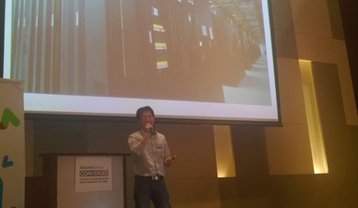Tencent, one of China’s largest internet service providers, has heavily invested in R&D for new technologies, including high voltage direct current (HVDC) and micro modular data centers.
The company’s senior data center architecture and planning engineer Li Dianlin spoke about Tencent’s innovations in these areas at the DCD Converged Shenzhen Conference late March.
Tencent’s micro modular data center
Tencent has already rolled out several versions of its micro modular data centers and after numerous tests and verifications, it has finally released what it classes as its ‘formal version’.
According to Tenent’s definition, a micro modular data center is an operation unit that is based on several racks and consists of cooling modules, power supply and distribution modules, cabling and monitoring systems.
“It’s like a sparrow, small but having all the five internal organs (heart, liver, spleen, lungs and kidneys),” Li says. “If we see servers as standard bricks, racks as kitchen, balcony or bathroom, then micro modules are a small suite. We can replicate and pile up (micro modules) to construct data center buildings and even the whole campus.”
Tencent’s micro modular data centers adopt innovative cooling and power supply solutions. They do not use raised floor cooling - which is quite popular in traditional data centers - but combine in-row cooling and cold aisle containment technology for reducing cooling power consumption and cost.
In terms of power supply, Li said most of Tencent’s data centers do not use traditional UPSs but switch to the power supply model of “HVDC (50%) + Grid (50%)”.
“By adopting the new power supply model, the efficiency of the grid power can reach 100% as there is no conversion loss; and by using the energy-saving Sleep Mode, the efficiency of HVDC power can reach more than 94%, hence resulting in an overall power efficiency of 97%. Upgrades can also transition the system to one which uses the grid as the primary power source and HVDC as backup for achieving a achieving power efficiencies above 99%,” Li says.
The Pingshan micro modular data center
Li refers to Tencent’s Pingshan Data Center as an example. Here the micro modular data center was used for rapid deployment and high levels of energy efficiency.
The Pingshan Data Center was built by the Shenzhen Subsidiary of China Unicom for Tencent. It is the largest micro modular data center to date that has been jointly built by Tencent (most of its micro modular data centers have been built with telecommunications partners).
In this project, ZTE Communications, a global ICT solution provider headquartered in Shenzhen, was the primary contractor. Tencent participated in the data center construction as a partner and formulated standards and regulations for relevant technologies.
Tencent’s Pingshan Data Center is completely made up of micro modules.
“In this project, we deployed 20 micro modules in Phase 1, and 40 in Phase 2, which brought online more than 1,200 racks in total. The whole project, from equipment delivered to the site to completion, took only four months. For Phase 2, it took 45 days to install, test and verify 40 micro modules. This demonstrates the advantages of easy replication and rapid deployment of micro modular data centers,” Li says.
There are two different models of the micro modular data center deployed at the Pingshan Data Center. One consists of 12 racks, the other of 18. “We installed micro modules made up of 12 racks in areas with columns, and micro modules made up of 18 racks in areas without columns. This method allows us to make full and flexible use of space,” Li says.
Power modules and in-row air conditioners within the micro modules here can be configured flexibly in accordance with the power capacity of IT racks. Currently, the micro module can support 12kW/rack at maximum.
Shenzhen, where the Pingshan data center is located, has a sub-tropical climate but by taking advantage of various technologies, including HVDC and grid electricity for power supply, in-rowing cooling and cold aisle containment, it achieves a low power usage effectiveness (PUE).
“Test results show that when reliability is guaranteed, the Pingshan Data Center can achieve a PUE at around 1.5 when it runs at one third of its workload. By increasing workloads and raising operation temperature, we are confident that the data center can achieve a PUE at around 1.4,” Li says.
Development trend
Micro data centers have seen increasingly wide application both in China and abroad.home and abroad. International internet players including Google, Facebook and Yahoo use micro modular technology to build their own data centers, while domestic ICT providers including Huawei, ZTE Communications, Inspur and C-Cube have announced their own micro modular data center solutions.
Li says he believes the future of micro modular technology will rest on standards and regulations built around the technology, something China’s Ministry of Industry and Information Technology is already developing.
“If we apply the micro modular technology to North China, it can be combined with natural air cooling, water-side economizers and air-side economizers, hence achieving even better energy efficiency,” Li says.

